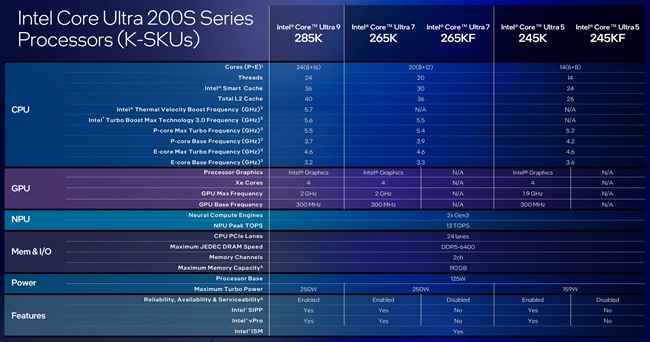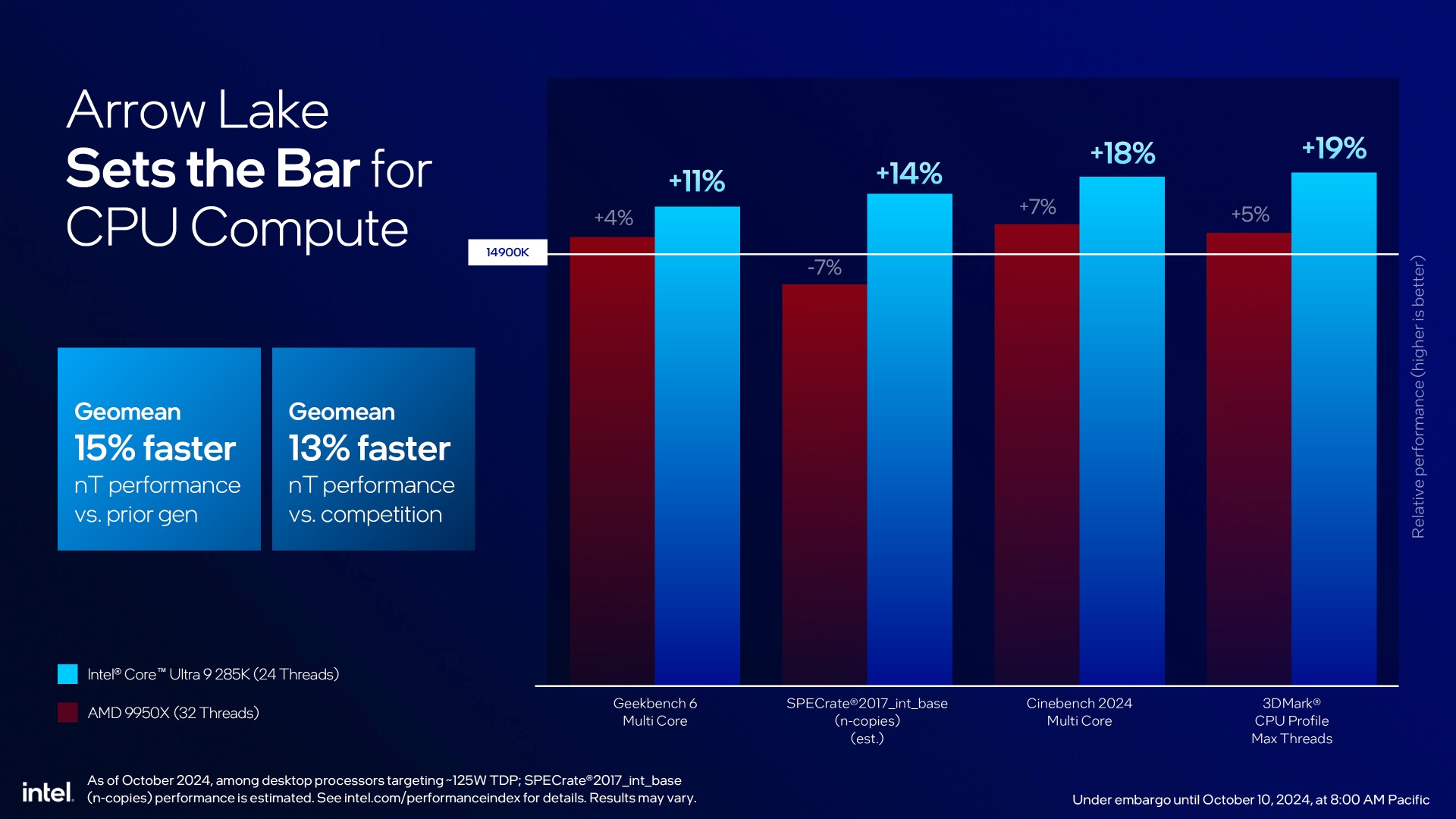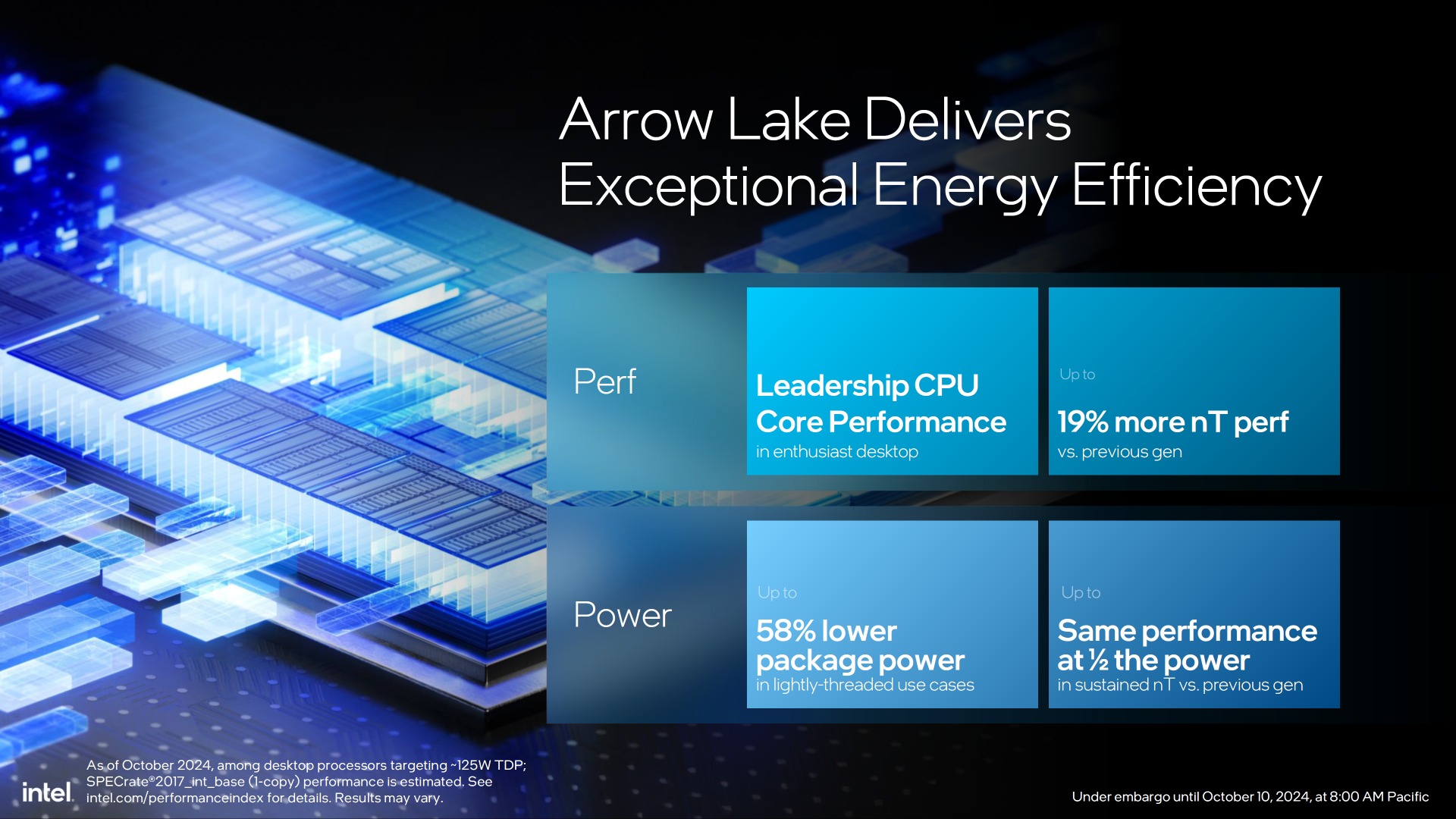
Intel on Thursday introduced its Intel Core Ultra 200S desktop processors, codenamed Arrow Lake-S, marking the debut of the first AI-focused enthusiast desktop PCs.
According to Intel, the Core Ultra 200S desktop processors aim to enhance performance in AI, gaming, and content creation while improving energy efficiency.
Part of a broader AI PC initiative alongside the Core Ultra 200V mobile processors, Intel claims these new desktop CPUs, supported by over 500 optimized AI models, will unlock AI’s full potential for users.
Core Ultra 200S Specifications and Features
The Intel Core Ultra 200 series emphasizes energy efficiency and introduces a new architecture combining Performance and Efficient cores with a desktop Neural Processing Unit (NPU).
The “S” in the naming convention refers to Arrow Lake-S, with the first versions being unlocked SKUs featuring a 125W thermal design power (TDP), targeting gamers.

Architecture Overview
The Arrow Lake CPUs adopt a design similar to Intel’s previous Alder Lake and Raptor Lake series, featuring two core types: Lion Cove P-Cores and Skymont E-Cores. Intel has removed hyper-threading in this generation, reportedly improving performance and efficiency, achieving a 15-20% performance boost.

Intel states that the Lion Cove P-Cores deliver a 9% improvement in instructions per cycle (IPC) over Raptor Cove cores, while the Skymont E-Cores offer a 32% performance increase over the Gracemont E-Cores from the 14th Gen Raptor Lake CPUs. Each P-Core has 3 MB of L2 cache, while a cluster of four E-Cores has 4 MB of L2 cache, and the CPUs share a maximum L3 cache of 36 MB.
The Arrow Lake processors also feature an updated Thread Director, which allocates threads based on workload demands. For gaming, this architecture shifts workloads to P-Cores when necessary, optimizing performance while maintaining power efficiency.

Graphics and AI Capabilities
The processors also feature an upgraded Xe-LPG integrated GPU, providing better graphics performance and AI computing power. Arrow Lake introduces the same NPU3 found in Meteor Lake processors, enabling dedicated AI computing tasks.

Six-Tile Architecture
The Arrow Lake CPUs consist of six tiles, including:
- Compute Tile (TSMC N3B)
- Graphics Tile (TSMC N5P)
- SoC Tile (TSMC N6)
- I/O Tile (TSMC N6)
- Filler Tile (N/A)
- Base Tile (Intel 1227.1)

These components are connected using Intel’s Foveros 3D packaging technology. The compute tile is notable for being manufactured on TSMC’s N3B process node, marking a first for Intel desktop CPUs.
Lineup and Specifications
The Intel Arrow Lake “Core Ultra 200S” lineup includes five SKUs, with three “K” and two “KF” variants:
- Intel Core Ultra 9 285K: 24 Cores / 24 Threads; P-Core: 3.7 GHz base, 5.7 GHz boost; E-Core: 3.2 GHz base, 4.6 GHz boost; 36 MB L3 Cache, 40 MB L2 Cache; 125W (TDP), 250W (MTP)
- Intel Core Ultra 7 265K: 20 Cores / 20 Threads; P-Core: 3.9 GHz base, 5.5 GHz boost; E-Core: 3.3 GHz base, 4.6 GHz boost; 30 MB L3 Cache, 36 MB L2 Cache; 125W (TDP), 250W (MTP)
- Intel Core Ultra 5 245K: 14 Cores / 14 Threads; P-Core: 4.2 GHz base, 5.2 GHz boost; E-Core: 3.6 GHz base, 4.6 GHz boost; 24 MB L3 Cache, 26 MB L2 Cache; 125W (TDP), 159W (MTP)

All SKUs support 24 PCIe lanes, 13 TOPs of NPU performance, dual-channel DDR5-6400 (up to 192 GB) memory, and feature four Xe iGPU cores with clock speeds up to 2000 MHz. The 285KF SKU will not be available at launch but may be introduced later.
Intel Core Ultra 200S “Arrow Lake” CPU Performance Overview
According to Intel, the Core Ultra 200S “Arrow Lake” processors offer significant improvements in performance and efficiency. In benchmarking tests, the Core Ultra 9 285K is reported to outperform competitors with a notable boost in single-core and multi-threaded performance.
Single-Core Performance:
-
- 4% faster than competitors.
- 8% uplift compared to the previous generation.
Multi-Threaded Performance:
-
- 15% improvement over the Core i9-14900K.
- 13% increase compared to the Ryzen 9 9950X.
Power Efficiency:
-
- Provides similar performance to the Core i9-14900K at half the power (125W vs. 250W).
- More efficient in multi-threaded tasks compared to AMD’s Zen 5 architecture.
Gaming Performance
The Core Ultra 9 285K also addresses previous issues with power consumption and heat in gaming. It runs cooler and uses significantly less power than the Core i9-14900K.
Performance Increase:
-
- Average increase of 0.35% compared to the Core i9-14900K.
Power Consumption:
-
- Uses 73W less power than the 14900K.
- Achieves 261 FPS in Assassin’s Creed Mirage while consuming 447W, compared to 264 FPS at 527W for the 14900K.


Thermal Performance:
-
- Operates up to 17°C cooler than the 14900K.
- Average temperatures range from 50-57°C compared to 60-70°C for the i9-14900K.
Additionally, the gaming performance remains consistent across different power limits, with the upcoming Core Ultra 7 265K expected to consume 188W less power while delivering slightly lower performance.



Intel’s First Desktop CPU With an NPU
The Core Ultra 200S series is Intel’s first desktop processor to include a Neural Processing Unit (NPU). Using the full compute power of its Arrow Lake chips, Intel provides 36 platform TOPs, supporting VNNI, DP4a, and NPU acceleration.
Although it doesn’t meet the 40+ TOPs requirement for Copilot+, desktop PCs with discrete GPUs can reach hundreds of TOPs to meet those demands. Intel emphasizes that integration with AI workloads is key, with its AI team working to enhance performance for various tasks.

For creators, Intel claims a 50% faster AI-assisted video editing, 8x faster playback for professional video codecs, and a 20% speed increase in ray-traced rendering compared to AMD’s Ryzen 9 9950X.
New Intel 800-Series Platform and LGA 1851 Socket:
The Arrow Lake processors will use the new LGA 1851 socket, replacing the LGA 1700.
These processors will run on Intel’s 800-series motherboards, starting with the Z890 chipset, which includes 48 PCIe lanes (20 PCIe 5.0 lanes from the CPU and PCH), 24 PCIe 4.0 lanes, and extensive connectivity options like USB 3.2 ports, eSPI, and SATA III links.

Key platform features include:
- Integrated I/O: 2 Thunderbolt 4 ports, Intel Killer Wi-Fi 6E, Bluetooth 5.3, 1 GbE
- Discrete I/O: Up to 4 Thunderbolt 5 ports, Intel Killer Wi-Fi 7, Bluetooth 5.4, 2.5 GbE
- Memory Support: DDR5-6400 (native) with speeds beyond 8000 MT/s via XMP, supporting up to 192 GB.


Overclocking Features
Intel offers overclocking options for Arrow Lake processors, including:
- Granular core clock tuning (16.6 MHz steps for P-cores and E-cores)
- Dual base clocks for SOC and compute tiles
- Tile-to-tile overclocking with dynamic fabric ratio changes
- DLVR bypass for extreme overclocking
- Memory overclocking with support for XMP and new DDR5 configurations

These processors have a TJmax (maximum operating temperature) of 105°C, providing ample headroom for overclockers.
Pricing and Availability
Intel’s Core Ultra 200S desktop processors will be available starting October 24 through global retailers.

Intel Core Ultra 200S Arrow Lake CPU pricing is as follows:
- Core Ultra 9 285K: USD 589 (Rs. 49,515 approx.).
- Core Ultra 7 265K: USD 394 (Rs. 33,120 approx.).
- Core Ultra 7 265KF: USD 379 (Rs. 31,860 approx.).
- Core Ultra 5 245K: USD 309 (Rs. 25,975 approx.).
- Core Ultra 5 245KF: USD 294 (Rs. 24,715 approx.).
Major motherboard manufacturers, including ASUS, Gigabyte, MSI, ASRock, and others, have released their Z890 motherboards on the same day.






